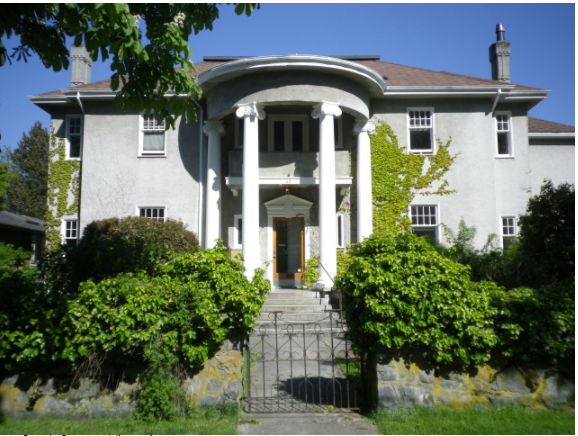In 1912, when it was tough for a woman to make a decent living, Christina Haas arrived in Victoria and bought herself a brothel.

Thomas Hooper once had the largest architectural practice in Western Canada. He designed hundreds of buildings including the Victoria Public Library, the Rogers Chocolates and the Munro’s Books Building in Victoria. And in 1912, the same year he designed Hycroft in Shaughnessy, Vancouver’s Winch Building and submitted plans for UBC, he designed Christina Haas’s, Cook Street brothel.
This is an excerpt from my chapter on the Red Light District in Sensational Victoria.
Cook Street Brothel:
It’s a gorgeous four-square house built in the Classic Revival style. According to the real estate blurb it was remodeled into a five-suite apartment complex in 1945 and it’s the first time the house has been on the market in 55 years. The going price is just under $2 million.
Christina is a shadowy figure. She arrived from California in 1912 at the age of 50 and took over an established brothel on Broughton Street with a steady clientele from the Union Club and Driard Hotel. Business was booming and she decided to move into a more upscale facility in Fairfield. She paid cash for the two lots and took out a building permit in her name and commissioned Hooper to design her brothel.
Thomas Hooper:
Although there is no mention of the Cook Street house in his portfolio, the blueprints are signed by the architect and bear his address. They show a house with three bedrooms, each with a separate entrance and its own bathroom. There are rumours that a secret door once led to a concealed wine cellar.
Neighbours tell stories passed down over the years. The women who worked at the Cook Street brothel wore business attire, and several married, raised families, and went about the rest of their respectable lives ignoring the occasional raised eyebrow and whisper.
Brothel changes hands:
Christina is listed as the owner of the property in the city directories until 1920. The brothel then sold to John Day, a wealthy businessman, and his wife, Eliza Amelia. Day owned the Esquimalt Hotel until it burned down in 1914. He also managed the Silver Springs Brewery and later the Phoenix Brewery. Eliza sold the house after his death in 1944.
Even after Day bought the Cook Street house, his tax notices were sent to Christina’s other brothel on Broughton Street, suggesting that he may have had an ownership stake in both.
Christina’s nephew Earl tells me his aunt sold all her brothel holdings in Victoria in 1919 and moved to Mendocino County to be near her brother John Henry and his wife Eva in Westport. She died in 1938 at the age of 76, and is buried in the Fort Bragg Rose Memorial Cemetery.
© All rights reserved. Unless otherwise indicated, all blog content copyright Eve Lazarus.


